new posts in all blogs
Viewing: Blog Posts Tagged with: commonplace book, Most Recent at Top [Help]
Results 1 - 17 of 17
How to use this Page
You are viewing the most recent posts tagged with the words: commonplace book in the JacketFlap blog reader. What is a tag? Think of a tag as a keyword or category label. Tags can both help you find posts on JacketFlap.com as well as provide an easy way for you to "remember" and classify posts for later recall. Try adding a tag yourself by clicking "Add a tag" below a post's header. Scroll down through the list of Recent Posts in the left column and click on a post title that sounds interesting. You can view all posts from a specific blog by clicking the Blog name in the right column, or you can click a 'More Posts from this Blog' link in any individual post.
“…I found the July days fly fast, and it was not until I felt myself confronted with too great pride and pleasure in the display, one night, of two dollars and twenty-seven cents which I had taken in during the day, that I remembered a long piece of writing, sadly belated now, which I was bound to do. To have been patted kindly on the shoulder and called “darlin’,” to have been offered a surprise of early mushrooms for supper, to have had all the glory of making two dollars and twenty-seven cents in a single day, and then to renounce it all and withdraw from these pleasant successes, needed much resolution. Literary employments are so vexed with uncertainties at best, and it was not until the voice of conscience sounded louder in my ears than the sea on the nearest pebble beach that I said unkind words of withdrawal to Mrs. Todd.”
—Sarah Orne Jewett, The Country of the Pointed Firs
On my mind constantly of late: notebooks, sketchbooks, art journals, and combinations thereof. Conversations are swirling in several of my circles—
• at Sketchbook Skool there is always lots of chatter about what people prefer to draw on and with;
• over at Wisteria & Sunshine, Lesley has been revisiting the topic of daybooks (especially handmade ones);
• Kortney is posting wonderfully enticing things about right-brain planning;
• Amy Ludwig Vanderwater is hosting a summer “Sharing Our Notebooks” project that I plan to participate in, soon as I get a chance…
Once a week I meet a small group of teenaged girls (one of them my Beanie) at a coffee shop to discuss literature while their younger siblings take piano lessons in the studio upstairs. This is hands-down one of the best hours of my week: meaty stories; lively analysis; word-collection; chitchat. A couple of weeks ago we ran off on a tangent of comparing one another’s notebooks. The conversation coincided with a similar thread at Wisteria & Sunshine, so I was primed. I’ve been using graph-style spiral-bound steno pads for the past year or so, with a modified bullet-journal method. (Chiefly the use of an index page at the front of each notebook—that was a game-changer for me.) But I was hankering after something less utilitarian-looking, and one of my lit girls had a new kraft-brown Moleskine that set me swooning. Back at home, I looked it up and it was exactly what I wanted. Slim paperback in the size I favor (Moleskine calls it “large” but it’s only 5×8), and—this was crucial—they offer a “squared” (graph-style) version.
I’ve used Moleskines before but mostly the Volant model with the bright solid-colored covers. So pretty on my shelf but you can’t really fold them back on themselves, and I don’t like writing on a double-page spread. That’s why I’ve mostly sighed and made do with spirals. But Moleskine’s Cahier model with a heavy paper cover is flexible enough for me to fold back. And I love the pocket in the back, such a nice touch.
Kraft paper is one of my favorite surfaces for decorating, so of course the cover cried out for some decoration. I started on the back in case I messed up. Still haven’t decided what I want to do on the front.
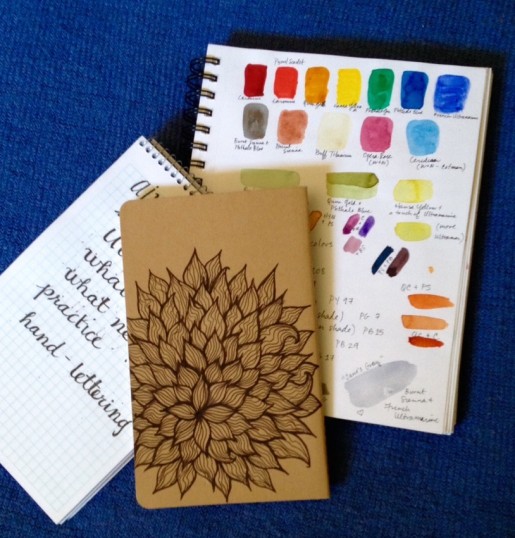
gridded steno notebook, kraft brown Moleskine Cahier journal, Canson Mixed Media Sketchbook
I love a skinny notebook not only because it fits easily in my bag, but because it fills up faster. I am mad for the fresh start. I had a few pages left in my May steno book but I craved a clean slate for June, so I’ve been using up the steno pages with hand-lettering practice.
I use my daily notebook for list-making, idea-sorting, story-outlining, note-taking…basically anything that involves words. Words + doodles, really: my “work” pages are always margined with crosshatching and basketweave and spirals and mushrooms…whatever. I used to try to keep things compartmentalized: one notebook for current book-in-progress; one for medical & insurance notes (I always seem to have volumes of these); one for quotes/commonplace book entries; one for to-do lists…but they always wound up melded together, and then I’d have three or four mishmash notebooks going at once, which was ridiculous. So I gave up and embraced my brain’s clear need to dump itself onto a page, melting-pot style, and now I let all those channels of thought intermingle. (Messily, much like the mingling of metaphors in that sentence.)
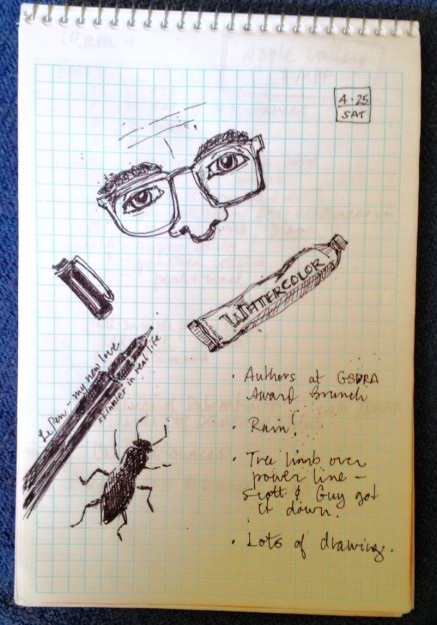
And these days my word-notebooks are overrun with drawings, too. I have a separate sketchbook—two, actually; a smaller (5×8) hardcover Moleskine that fits in my bag, and a larger (7×10) Canson mixed-media sketchbook that is my place to experiment with drawing techniques and paint. That’s where I do my Sketchbook Skool assignments—it’s my it’s okay to screw up place. Consequently, it sees way more action than the Moleskine sketchbook, which I pretty much only use when I’m 1) away from home and 2) feeling unobtrusive enough to draw in public. I don’t mind kids looking over my shoulder but I’m way too shy about my work to want adults eyeballing it in progress.
Interestingly, the Canson Mixed Media Sketchbook is the one that got a thumbs-down from Roz Stendahl (THE source of in-the-field info on all things art supply), and when I read her review I had a major light-bulb moment: Ohhhh, so you mean the paper isn’t supposed to buckle when I paint? This Canson (I’m in my second one now) is the only sketchbook I’ve ever painted in, so I thought that’s just how it went, unless you bought one with watercolor paper. Roz’s report clued me in to the possibility that the book I picked (entirely because it was on sale at Michael’s) may not perform as satisfactorily as other brands. I’m nearing the end of this one (you guys!!! I’ve filled two whole sketchbooks with drawings!!) and may take Roz’s recommendation and try a Strathmore Journal Series’ Mixed Media book next time. Does Michael’s sell them, I wonder? Got another coupon burning a hole…
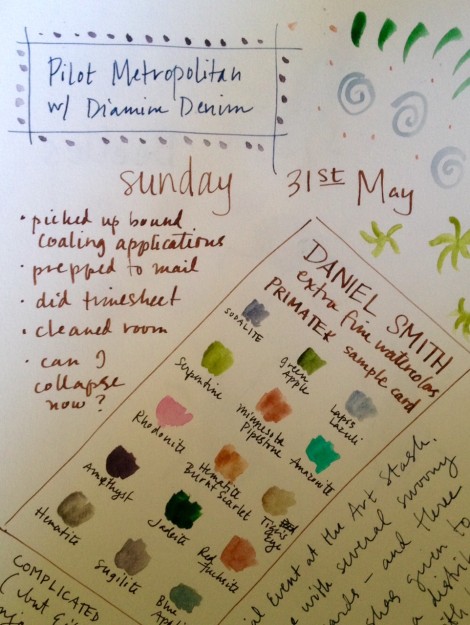
bad phone photo; can’t be bothered to scan
Okay, so I was saying that in theory I have the sketchbook(s) for, well, sketching, and the notebook for all the word things, but the truth is that ever since I started working on my drawing skills last fall, I’ve got rough sketches running wild all over my word-notebooks. Again, this is something I’ve just decided to be at peace with. So much of my work involves a rigorous process of polishing and structure, and I think perhaps my mind really needs a place to be messy and unfiltered, a place to set itself down in raw form. It’s like a test kitchen for my thoughts, I guess. This is where the index is so invaluable: it allows me to quickly locate the notes from that Very Important Phone Call without having to hunt through pages of nonsense. I try to update the index at least once a week—just a mild leaf-through to note down the page numbers on which I have recorded important information. I number the pages of my notebooks in the bottom right corner, about ten pages at a time. I like to write my to-do lists on a Post-It that can travel from page to page. As each task is crossed off, I jot it down in the notebook for a record of what I’ve done.
Since the ugly steno books all look the same on the shelf, I would run a highlighter down the sides of the pages, a different color for each new book. But so far the kraft Moleskine is serving beautifully, and I doubt I’ll go back to the steno grids. I might use a bit of Washi tape on the spine to differentiate the Moleskines on the shelf, once they’re filled.
***
Back to my coffee-shop girls. We had so much fun that day, comparing notebook preferences, that we decided to all bring our sketchbooks the following week. Which was truly delightful—what a treasure, this look at the outpouring of creativity from these girls. Beautiful design work (I mean really breathtaking, some of it), whimsical drawings (much more skilled than mine), and illustrated quotes, and just so much wonder, so much evidence of curious minds sifting the world. I felt really honored to have this work shared with me. We are nearing the end of the topics we charted for our class, but the girls begged me to keep going through the summer. So we’re thinking of spending a few weeks on sketching and notebooking. I have all sorts of ideas for things we can do together—heavily Lynda Barry-influenced, naturally, because who better to guide you through an exploration of all the things a sheet of paper can become?
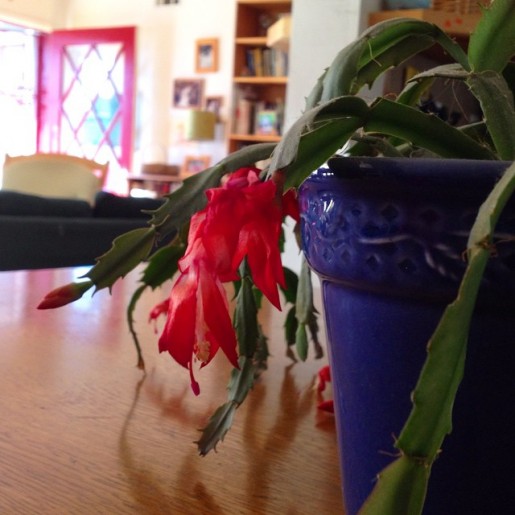
Ours is in bloom this very day, as it happens
“Our Christmas cactus has predictably bloomed each December for three decades and some years when it has been colder for longer, as is the case this year, it often blooms more than once a year. Our Christmas cactus is alive and growing 365 days of the year, most of which it is rarely seen by me but only looked at.”
That’s Owen Swain in his post “Blooming Cactus / blooming an illustrated life / and, what I learned in Sketchbook Skool.”
In his drawing of the cactus, he includes a quote which sent me immediately dashing for my commonplace book (which is to say, this blog).
“While drawing grasses I learn nothing ‘about’ grass, but wake to the wonder of this grass and its growing, to the wonder that there is grass at all.”
—Frederick Franck
That. Yes. Exactly. Or at least, I suppose I would say I learn something about grass when I’m drawing it, I learn something about everything I look at closely. But that kind of learning is implied in the quote. I get what he means by ‘about.’ And yes, the waking to the wonder of a thing by observing it quietly, moving your pen along its paths, or by writing a poem about it (“This grasshopper, I mean—/ the one who has flung herself out of the grass,/ the one who is eating sugar out of my hand, who is moving her jaws back and forth instead of up and down—/ who is gazing around with her enormous and complicated eyes…”)*; even, I daresay, by blogging about it—the combined act of observing, pondering, and then expressing, in word or line—these endeavors shift your relationship with the humble object; they awaken you to the wonder the thing actually is.
The very first revelation that struck me about drawing, way back in college during a too-brief foray into sketching, was the passage in the Betty Edwards book Drawing on the Right Side of the Brain in which one of Betty’s students mentioned that after she began trying to draw faces, “every face I looked at seemed beautiful to me.” I have written before about the enormous impact that statement had on me, not just in relation to drawing but to an overall view of life.
The drawing lessons taught her to really look at people, and when she did, she saw beauty everywhere.
I know I’m going all over the place here, but in my mind these things are all connected: this way of really looking, really seeing, noticing what is interesting and important and even beautiful about things many people whisk by without noticing. And what I can do for my children is refuse to fill up their lives with things they must patiently endure until a better moment comes. I can savor the moments as they happen, and give them the time and space to find what’s interesting and beautiful in every face the world shows them.
As I was writing that last sentence, Beanie appeared in front of me with a big smile and a present: a bracelet made of safety pins linked together, each pin shining with green and blue beads. “It’s for you, Mommy,” she breathed, so proud and excited. “Jane showed me how.” How patiently (the good kind of patience) she must have worked to slide all those beads in place.
I never noticed before what a work of art a safety pin is!
I’ve written so many times on this blog about how my approach to education is to keep the focus on the process, not the product. The lesson is renewed for me every time I take pencil in hand and try to capture the lines of a thing on my page. In the end, it doesn’t matter at all how my drawing ‘turns out.’ The magic is in the doing.
*From “The Summer Day” by Mary Oliver
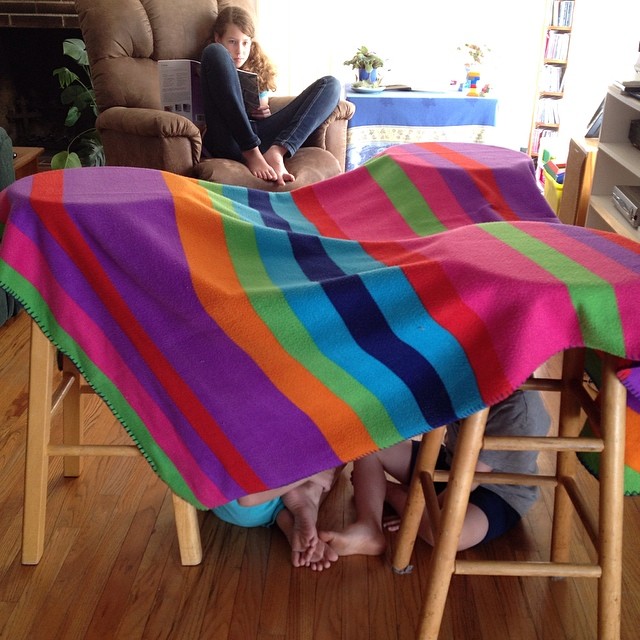
You know how you have that friend you used to talk to on the phone all the time, every day practically, so that even though you lived hundreds of miles apart, you were totally up on all the daily details of each other’s lives? And then along comes a busy week, maybe two, and you play a few rounds of phone tag, and suddenly there’s SO MUCH to catch up on that you know you’re going to need an hour, probably more, who are we kidding, and so you’re both waiting for a nice long chunk of time and meanwhile more life is happening and you’re never ever going to be able to catch each other up on all of it? Yeah, that’s how I’m feeling about my book log today. 
For a few weeks there I was trotting along at such a nice clip, recording everything—not only books finished, which I’ve been faithfully logging since 2008, but fragments and sections of books, history and science chapters read to the kids, picture books, substantive internet articles, even individual poems. I’ve never kept track of my reading to such a granular degree before, and I was really enjoying it—both as a chronicle of the many branchings of my interests, and as a somewhat, for me, revelatory indication of the sheer amount of reading, challenging and otherwise, that I was doing all along but somehow not “counting.” Sigh, I only read two books this month, I might think, looking a year from now at my GoodReads tally for April 2014, forgetting the quantities of poetry I devoured that month (just no complete books of poetry, so they don’t qualify for a GR entry), the hundred-odd pages of mid-19th century American history and 17th-century science my girls and I tackled together, the Scientific American articles, the half a novel that didn’t hold me, the five or six opening chapters I sampled on Kindle, the dozens of picture books enjoyed with my younger three, the lecture transcripts, the Damn Interesting articles, the AV Club reviews. Of course it all counts. It all goes to the shaping of me, the stretching of me. My old book log, the finished-books-only kind, presents a comically, unrecognizably skewed picture. Presents this skewed picture to me, I mean—I’m not supposing that anyone else is troubling themselves about it  —but future me will be much hazier about what riches were crammed in between those gaps in the record, the blank spaces between The Tuesday Club Murders and The Wheel on the School.
—but future me will be much hazier about what riches were crammed in between those gaps in the record, the blank spaces between The Tuesday Club Murders and The Wheel on the School.
I’ll want, you know, to remember how that April (this April) was the month of Donne and Herbert, and of The Secret Garden, and of The Little Fur Family and The Americans (the TV show, not the James novel) and Beginning Theory—how way led to way, and reading up on Donne turned into teaching a poetry class, and how things we were reading in The Story of Science kept cropping up on the new Cosmos the very next night, and vice versa.
Until I began the granular logging in March (was it March?), I hadn’t realized how much reading was happening in the margins. Then I missed a day, and the next day there was more to catch up on, and so on and so on, and there went April. All this to say I’m going to start over (again) and see how long I can keep it up this time—and if I miss a day, I’ll let it go, like a balloon floating away into the sky, and not lose hold of the next day’s balloon in an attempt to retrieve the first.
(But if I remember what color the lost balloons were, I can say so. I remember some of yesterday’s balloons.)
Yesterday I happened upon a long piece called “Selling Henry James,” a Northwestern University professor’s account (in 1990) of his experience teaching a James seminar to undergraduates one quarter. Very enjoyable read. I got there via a Jamesian rabbit trail, which branched off a Virginia Woolf rabbit trail, which started actually last fall (and now I can’t remember why; didn’t log it!) and was rediscovered—oh, gosh, I’m losing track of the meanderings. I’ve been watching these Milton lectures at Open Yale, and I think it may have been something the professor said in one of those that made me jump back to Woolf, and then to Gilbert and Gubar’s Madwoman in the Attic, which I’ve never read til now—it took me most of last week to get through the two introductions and the first chapter, but I don’t mean “get through” in a negative sense, it was fiercely interesting reading, and amusing in that I realized, a little way in, that this is the text which most deeply informed the women’s lit class I took in college, though Madwoman itself was never assigned. That was the fall of 1988, fourteen years after Madwoman was published, and our professor was in her first year of teaching. I’ve had fun fitting these pieces of the puzzle together.
Earlier this week, still on the Woolf trail, simultaneous with Madwoman, I landed on this site and read the “Women’s Images in Literature” lectures in their entirety. Mostly for review, but like everyone I have gaps. Came away with yet more books to cram into the impossible queue.
The picture book Huck keeps asking for this week, and which I don’t mind reading over and over—the art is so lush, the colors (deep blue and gold) unusual, and the story sweet—is The Bear’s Song, which I was so glad to see make it to our list of finalists in last year’s CYBILs contest.
Rilla and I are nearly finished with The Secret Garden. Mrs. Sowerby had to conspire to send the children more food today, they’re starving all the time. I don’t want it to end.
The girls and I are on to Robert Burns now, today was “To a Mouse.” I always do “To a Mouse.”
We’ve returned to our French songs—we forgot about them for a while—”Promenons Nous Dans le Bois” and “Les Éléphants” from the on the French for Kids: Cha Cha Cha CD, mostly. And a lot of Robert Burns songs on YouTube, and (for no particular reason) this rendition of Waltzing Matilda.
The Henry James article left me in a James mood (no, I suppose the mood was already creeping over me and that’s why I googled it?) so last night at bedtime I barraged my Kindle with his books, and this morning I fell into The Turn of the Screw, which I’ve never read (I’ve only read Portrait of a Lady, Daisy Miller, and Washington Square) and can’t wait for bedtime tonight so I can (try to) return to it. (The parentheses are because I’m still not managing nighttime reading, only crossword puzzles. Two nights ago I tried to read in bed. I remember nothing, but next morning when I opened the Kindle app on my phone, there was the E.M. Forster Collection open to his short story, “The Celestial Omnibus,” which I’d never read before. I fall asleep, and my finger hits the touchscreen, and I find surprises the next day, like this one. Forster was near the top of the library screen because of my binge in March. I read the Omnibus story and the next one, the one about the beech wood, “The Other Kingdom,” I think it’s called?, and then I had to go back and reread the last chapter of Howards End. (A part of me is always rereading the last chapter of Howards End.)
Before I end (with no conclusion), a James note and a James quote. The note is that, settling into (or being inexorably pulled into, I had no choice) Turn of the Screw and working, as one must, to keep up with the twistings of the sentences, I had this sudden rush of comfort—I don’t know how else to put it—of relief, really, in the realization that a thing about Henry James is that you can trust him to get you there in the end. To the end of the sentence, I mean. It’s going to have forty parts but in the end they will all hold together. I didn’t comprehend that the first time I read him, in my twenties. It’s like knowing a piece of music is going to resolve at the end of the phrase. The final chord will bring you back to the ground. Perhaps I’m a more patient reader now (now that I’m resigned to not getting through ALL THE BOOKS), or perhaps I’ve learned enough about craft over the years to know when a writer deserves my confidence. And I mean this observation only about syntax, about style—I don’t expect James to hand me the plot resolution I crave, he made that very clear at the start of our relationship (oh Isabel!)—but I find there’s an unlooked-for joy in trusting him on style.
And the quote: “Never say you know the last word about any human heart.”
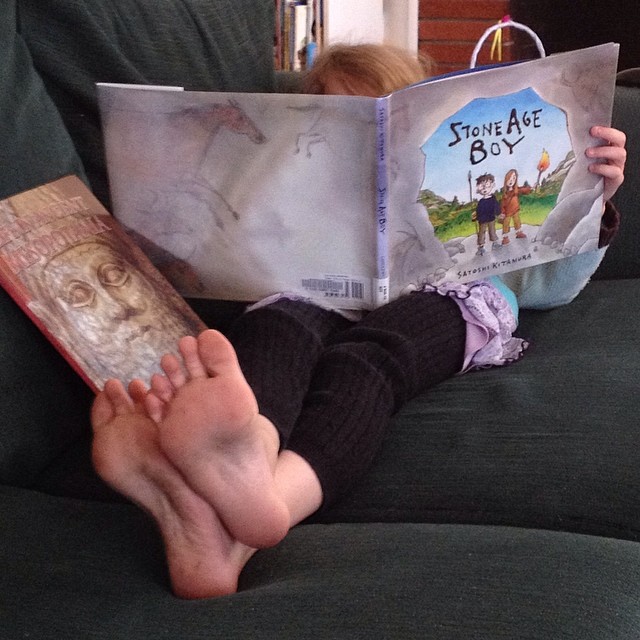
Books are easy. Books I log elsewhere. And yet the only book I entered at GoodReads in April was The Wheel on the School. Can that be right? It’s true I went into one of my periodic reading lulls after my ravenous appetite in March. That’s become my pattern, it seems: a feverish binge and then a (usually sudden) inability to settle on anything, a stretch of weeks when I reach for crossword puzzles instead of a book at bedtime.
I think I needed time to digest after the rich feasts of March!
• The Remains of the Day, Kazuo Ishiguro
• The Blue Flower, Penelope Fitzgerald
• The Giver, Lois Lowry
• Queen of England: The Story of Elizabeth, Helene Hanff
• And my Forster binge: A Room with a View, Where Angels Fear to Tread, Howard’s End
With Rilla, The Secret Garden—we are a few chapters from the end. And the usual range of history, science, and poetry with Rose and Beanie, and picture books and beginning readers to my three youngest.
Poetry has been delightful; Herbert last week and Herrick and Marvel this week. Next week brings us to Milton, and to prepare, I’ve been watching these lectures at Open Yale. Extremely engaging. Milton’s one of my gaps. Never studied him formally, had only read bits and pieces, and knew him largely through quotes and references—especially Dorothea’s repeated comparisons of her Mr. Casaubon (shudder) to the esteemed poet. This lecture series has been wonderfully illuminating and I’m glad I finally stopped passing it by in favor of other courses.
Also re-read a good bit of Jane Eyre (for discussion with Rose) and watched this lecture on YouTube. I wish the professor had been credited; I’d like to seek out more of her work. Quite good.
Rose and I started off reading Gulliver’s Travels together but she surpassed me and I doubt I’ll catch up now that she’s finished. Gulliver isn’t quite what I want when my head hits the pillow after a crammed-full day.
Hang on! I read Miss Marple stories all through April! Huh, they aren’t showing up on my GoodReads list. Probably forgot to enter the date. Well, it was The Tuesday Club Murders, which I’d read before. I remember now: I had a cold, and Christie is always my go-to reading when I’m sick.
This week’s reading has included a lot of prep for a new endeavor of mine: now that Mystery Class is over, I’m going to do a six-week poetry workshop with my Journey North kids. Very excited about this. Starts tomorrow.
Of course, some of my most fascinating (and challenging) reading has been for my editing job—a delicious gig for a knowledge junkie like me. But it, too, contributes to my late-evening literary slothfulness. By ten o’clock, my brain is quite simply done with words—except the kind that fit one letter at a time into little boxes.
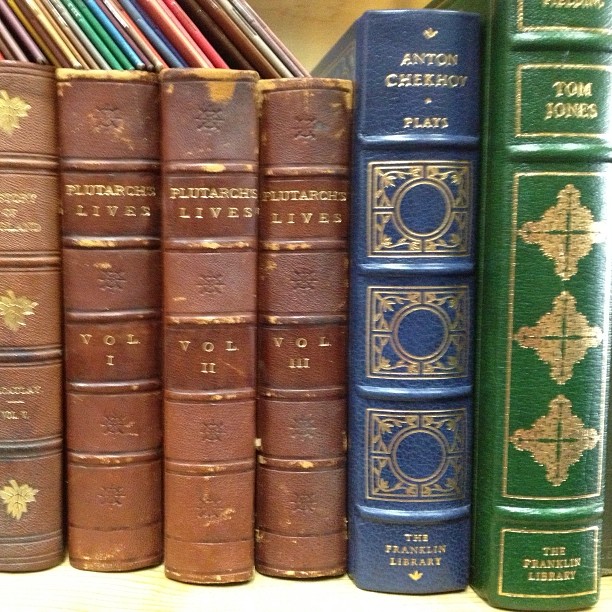
As long as I’m keeping a record of daily reading, I figured I ought to keep track of the academic lectures I’m taking in as well.
Recently:
George Eliot: Intellect and Consciousness. Catherine Brown, Oxford.
Darwin and Design, Lecture 1. James Paradis, MIT.
American Novel Since 1945, Lectures 1-13. Amy Hungerford, Yale.
Introduction to Theory of Literature, Lectures 1-3, 5-6. Paul Fry, Yale.
Modern Poetry, assorted lectures (I’m skipping around). Langdon Hammer, Yale.
MOOCs in progress with kids:
Moons, The Open University FutureLearn.
Shakespeare and His World (selected videos), University of Warwick, FutureLearn.
Live!: A History of Art for Artists, Animators and Gamers, California Institute of the Arts.
Coursera courses on my own, in progress or recently:
Scandinavian Film and Television. Multiple instructors, University of Copenhagen. Course in progress. Have watched vids for weeks 1-3 so far.
Human Evolution: Past and Future. John Hawks, University of Wisconsin-Madison. Course just ended. Watched about half the videos. Loved how the professor traveled to various digs and fossil sites.
Plagues, Witches, and War: The Worlds of Historical Fiction. Bruce Holsinger, University of Virginia. Watched all videos, read several of the books. Great course!
Climate Literacy: Navigating Climate Change Conversations. Sarah Burch & Sara Harris, University of British Columbia. Did about 75% of the course—videos and readings. Showed several of the video lectures to my teens. I wish everyone I know would take this class. Hope it will be offered again.
Modern & Contemporary American Poetry. Al Filreis, University of Pennsylvania. Watched about half the videos, did corresponding readings. I adore this course and look forward to taking it again—in full this time—in the fall.
A Brief History of Humankind, Yuval Noah Harari, Hebrew University of Jerusalem. Lectures 1-4.
The Modern and the Postmodern. Michael Roth, Wesleyan University. Weeks 1-5. The reading load got to be more than I could juggle at that point in time but I very much enjoyed the lectures I watched.
***
There are so many appealing courses in literature alone (see this big list at Open Culture), not to mention all the classes I’d like to take in anthropology, history, art history, and various sciences. The Tolkien Professor’s Faerie and Fantasy class sounds especially fun! We were discussing these courses on Twitter this evening and a friend mentioned that she’d love to take one of these, but would be unlikely to finish. I seldom complete an entire course, as my Coursera record above demonstrates. But that doesn’t concern me; I consider each lecture I listen to a gain. I ran out of time to listen to all the Human Evolution lectures, but I learned a vast amount from the ones I did manage to watch. Ditto all the above. I’m exactly halfway through Amy Hungerford’s series on the modern American novel, and while I certainly hope to listen to the rest of the lectures, even if I don’t get back to them I’ve already gained a tremendous amount in terms of new knowledge and food for thought. This is unschooling for adults, and it’s exhilarating—learning as process, not product (that same philosophy that informs our homeschooling life).
There’s never any knowing—(how am I to put it?)—which of our actions, which of our idlenesses won’t have things hanging on it for ever.
—E.M. Forster, Where Angels Fear to Tread
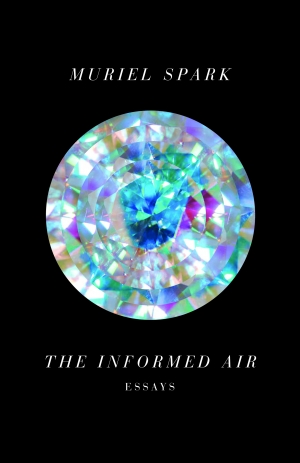
“I’ve never met a really good writer who lives in high style. I think a stylish life is unsuitable to the writer, and very often in the house where there’s a mild disorder one finds the writer with the best powers of organising his work. Order where order is due.”
Muriel Spark— “The Poet’s House”
Read this and many other wonderful essays by Muriel Spark in The Informed Air, which will be released by newdirectionspublishing on April 29th.
(Source: kevinelliottchi, via maudnewton)
(I’m counting the days until this book comes out!)
It occurred to me that I could use the voice-record feature on my phone to dictate a quote directly into Evernote. Then, later, when I’m back at my laptop, I can clean up the typos (voice recording always generates some gems) and paste the quote into my Tumblr, which, as I mentioned the other day, I’ve decided to try out as my commonplace book.
I’m still using my tumblr to collect other articles as well, but I’m using a tag to collect all the book quotes I want to hold on to. So far, I’m enjoying the process: the format encourages me to add my own thoughts below a quote, if I wish, but there’s no pressure.
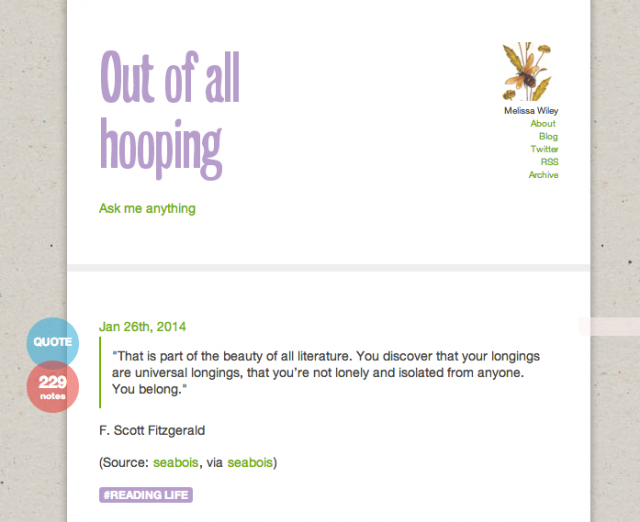
Bee avatar from Lesley Austin of Wisteria & Sunshine
Ryan Holiday on How And Why To Keep A “Commonplace Book”:
A commonplace book is a central resource or depository for ideas, quotes, anecdotes, observations and information you come across during your life and didactic pursuits. The purpose of the book is to record and organize these gems for later use in your life, in your business, in your writing, speaking or whatever it is that you do.
Some of the greatest men and women in history have kept these books. Marcus Aurelius kept one–which more or less became the Meditations. Petrarch kept one. Montaigne, who invented the essay, kept a handwritten compilation of sayings, maxims and quotations from literature and history that he felt were important. His earliest essays were little more than compilations of these thoughts. Thomas Jefferson kept one. Napoleon kept one. HL Mencken, who did so much for the English language, as his biographer put it, “methodically filled notebooks with incidents, recording straps of dialog and slang” and favorite bits from newspaper columns he liked. Bill Gates keeps one.
Not only did all these famous and great individuals do it. But so have common people throughout history. Our true understanding of the Civil War, for example, is a result of the spread of cheap diaries and notebooks that soldiers could record their thoughts in. Art of Manliness recently did an amazing post about the history of pocket notebooks. Some people have gone as far as to claim that Pinterest is a modern iteration of the commonplace book.
Fun to hear thoughts on this topic from someone outside homeschooling circles. Apart from a few quiet book bloggers, nearly everyone I know who is familiar with or interested in commonplace books is a homeschooler.
I’ve tried many interations of the practice over the years. (This recent Onion piece made me laugh, because I relate all too well to the feeling that just the right notebook and just the right pen will make, this time, all the difference—only re quote-keeping rather than creative writing.)
It’s always the copying out by hand that gets me. I bookmark quotes all over the place (via Diigo, Tumblr, or Evernote, depending on whether I want to share them, if indeed I want to share them at all). And I highlight the dickens out of the things I read on Kindle. But as methods go mine are pretty scattered—and, except for the Kindle highlights, only cover my internet reading. I’ve no single place to go to pore over passages that have struck me in, you know, books made of paper.
Mental Multivitamin has made a consistent practice out of commonplace-book-style blog posts for some ten years, recording quotes that struck her in the books she has read. Would that I had followed her example. The paper-loving side of me craves a handwritten version, but realistically I know myself (and my achy wrists) well enough to know that I would wind up with that dogeared stack of waiting books Ryan mentions in his post—the very thing he cautions you to avoid. Typing is always going to work better than writing, for me.
I wonder if I would keep up with a Commonplace Tumblr? Typing or pasting book quotes into that platform? Same principle, easier on the wrists. It would certainly be a steadier use of my tumblr than the haphazard link-collecting I do there. (My original vision for my tumblr back in 2009—good grief, has it really been that long?—was to collect links to all the reading I do online, or all significant reading, at least: a companion to my reading log. That didn’t pan out over the long haul.)
***
I began this post a couple of days ago and have since decided to give it a try. I’ve hit the reset button on my tumblr (figuratively) and am going to try to copy out book quotes into once or twice a month. It’s an experiment; I may lose steam after a while, but we’ll see.
(I could do it here instead, but when I post things here I feel more pressure—entirely self-imposed—to add my own commentary. Over there I don’t seem to mind tossing a quote onto the page and letting it speak for itself. Then, if I have more to say—as indeed turned out to be the case with the article above—I can bring it over here and expand upon it.)
***
While finishing up this post just now, I was amused to find “commonplace book” among my categories. I probably made a similar resolution years ago. Didn’t take, obviously.
“The difficulty of getting rid of even one half of one’s possessions is considerable, even at removal prices. And after the standard items are disposed of—china, rugs, furniture, books—the surface is merely scratched: you open a closet door and there in the half-dark sit a catcher’s mitt and an old biology notebook.”
—E.B. White, “Removal,” One Man’s Meat

“…you should think of will-power as something that never exists in the present tense, only in the future and the past. At one moment you have decided to do or refrain from an action and the next moment you have already done or refrained; it is the only way to deal with will-power….I offer this advice without fee; it is included in the price of this book.”
—Mrs. Hutchins, the narrator of Muriel Spark’s A Far Cry from Kensington
.jpeg?picon=2982)
By: Caroline Starr Rose,
on 10/26/2012
Blog:
Caroline by line
(
Login to Add to MyJacketFlap)
JacketFlap tags:
reading and writing,
life choices,
commonplace book,
unkeep,
perspectives on reading,
what I am reading,
intentional living,
writing advice,
the writing life,
authors,
writing,
inspiration,
quotes,
me,
style,
Add a tag
For those of us living the writing life, whether we realize it or not, we are constantly learning as we read. Often I'll find myself engrossed in a book where the author's voice becomes so familiar I swear I'll never forget its rhythms and style. And while I sometimes can hold onto a general sense of these things, I'm finding I need to be more intentional with my reading if I want these impressions to last.
This year I've started using my
commonplace book as a place to record quotes that have struck me as important. Sometimes it's a fresh simile, other times just a sentence to remember the atmosphere an author has so wonderfully invoked. I've recorded the last few pages of novels, those key moments when everything comes together. I've written down scenes when the protagonist reaches the end of his or her self and must become something new.
It's in looking for and taking note of things that I'm learning to grow as a writer.
Here are a few similes and metaphors I've collected these last few months:
"Alice's stomach was rumbling like an empty garbage can rolling down a hill..." PIE, Sarah Weeks
"I try to stuff myself between the seats, like coins." EMILY'S DRESS AND OTHER MISSING THINGS, Kathryn Burak
"Majid had a family network as complex and secretive as a walnut shell." THE RUINS OF US, Keija Parssinen
"Her voice sounds as hollow as the empty wasp's nests." CROSSED, Ally Condie
"The day is collapsing into dusk. The Gypsies in their white shirts are the only lamps. The moon is coming in like a pan on fire." SMALL DAMAGES, Beth Kephart
And some darn
beautiful truths:
"I lay my hand on my heart. Our parents teach us the very first things we learn. They teach us about hearts. What if I could be treated as though I were small again? What if I were mothered all over again? Might I get my heart back?
My heart is unfolding." CHIME, Franny Billingsley
"That taste is still in my mouth. I know what it is. It's the taste of pretending. It's the taste of lying. It's the taste of a game that is over." LIAR AND SPY, Rebecca Stead
"In spring, Amherst changes into a storybook. The students grow wings from their heels and run through town spinning and singing. You get the idea that some parts of life are pure happiness, as least for a while. The toy store in the center of town puts all its kites outside, on display, so that the tails and whirligigs can illustrate the wind." EMILY'S DRESS AND OTHER MISSING THINGS, Kathryn Burak
What helps you process what you learn as you read?
Hello, everyone! The last couple of weeks have been hectic for Dava Books. Preparing Overtaken for a September 30 publication date is both nerve wracking and an occasion for celebration.
After umpteen months of writing, editing, and endless rewriting, it's going to feel very odd to not have the Overtaken manuscript in my life anymore. Every time I finish and release a book I go through a mini-version of empty-nest syndrome; a good reason to have a fun project ready and waiting to fill the void. This time it's going to be starting my commonplace book, as well as doodling on some screenplay ideas.
Over the weekend I used my store credit at a local indie bookstore, Page One, to buy this luscious journal for my first attempt at commonplacing. I think it's the perfect choice: a magnetic fold-over closure to keep the pages tidy; slim enough to fit in a tote or large handbag; a full-size cardboard pocket fitted to the inside back cover for slipping in cards and gallery notes; smooth, creamy, top quality paper. It also just looks so inspiring. The cover's old-world patina already has an antique feel that makes me think of magic, mysteries, and museums. I can't wait to start filling it up!

For many years I've been intrigued with the idea of the "commonplace book," a type of journal- or notebook-keeping system that dates back to the seventeenth century. Two of my favorite examples from more modern times include E.M. Forster's Commonplace Book and A Writer's Commonplace Book by Rosemary Friedman. Basically the idea behind creating a commonplace book is to have a written record of meaningful or important instructions and reminders that you would not ordinarily find in any one place. The two books I've mentioned above concentrate on the art of writing, but I've read others that are a wonderful hodge-podge of obscure and fascinating factoids, from graveyard inscriptions to medieval recipes for swan pie.
and A Writer's Commonplace Book by Rosemary Friedman. Basically the idea behind creating a commonplace book is to have a written record of meaningful or important instructions and reminders that you would not ordinarily find in any one place. The two books I've mentioned above concentrate on the art of writing, but I've read others that are a wonderful hodge-podge of obscure and fascinating factoids, from graveyard inscriptions to medieval recipes for swan pie.  If you're like me and have kept any kind of journal at all, you've probably unwittingly been creating a kind of commonplace book without even knowing it. When I re-read many of my journals I'm always discovering notes on recommended book titles or a writing friend's best advice on how to create a scene or write a pantoum. One of the reasons I've been reluctant to part with my journals is the fact that if I tossed everything out I'd be losing several volumes-worth of good advice. Finding that advice when I need it, however, can be a major headache, especially when most of it is hiding between old morning pages, drafts for long-ago published novels and poems, and all the rest of the usual stuff that goes into a journal. So here's my plan for separating the sheep from the goats: Create a dedicated commonplace book! This first attempt, I've decided, is going to center around an art theme. Some of the things I want to include are:
If you're like me and have kept any kind of journal at all, you've probably unwittingly been creating a kind of commonplace book without even knowing it. When I re-read many of my journals I'm always discovering notes on recommended book titles or a writing friend's best advice on how to create a scene or write a pantoum. One of the reasons I've been reluctant to part with my journals is the fact that if I tossed everything out I'd be losing several volumes-worth of good advice. Finding that advice when I need it, however, can be a major headache, especially when most of it is hiding between old morning pages, drafts for long-ago published novels and poems, and all the rest of the usual stuff that goes into a journal. So here's my plan for separating the sheep from the goats: Create a dedicated commonplace book! This first attempt, I've decided, is going to center around an art theme. Some of the things I want to include are:













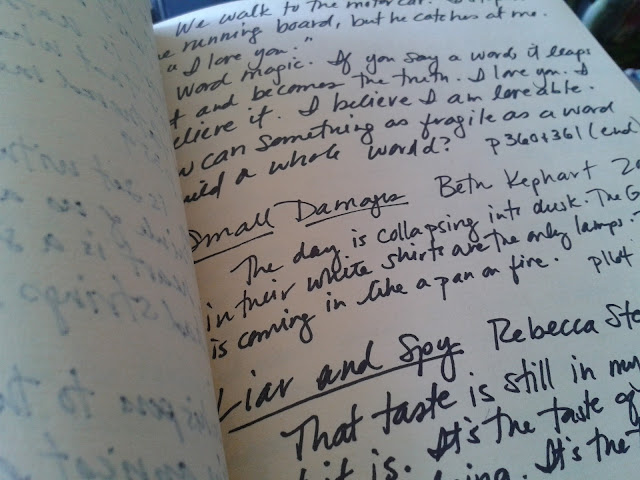


I haven't been purposeful about learning as I read. I do make it a point to talk about the books when I finish them, especially if something really worked for me, or really didn't. But this journaling idea is a good one.
I love those quotes!
I've really loved collecting sentences and scenes this way. It's been a great learning experience and is a bit like a scrapbook, too.
For years I've thought about doing this, but am too lazy or distracted to actually DO it. I'm impressed, Caroline. And I love the quotes you chose, too. And your pretty notebook!
I don't do it as often as I could, but every time I have, I've benefitted.